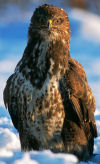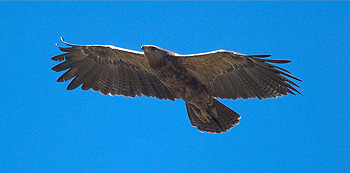Nature » Animated nature » Fauna
Fauna
Birds
 In the area of the Magura National Park 137 species of birds have been found, 117 of them breed here. Very interesting elements of breeding birds are the birds of prey. There are 13 species in the Carpathians, out of 19 nesting in Poland, and 8 of them breed in the Magura National Park. The most numerous bird of prey is Common Buzzard Buteo buteo, which density is about 60 pairs per 100 km2 of the Park’s area being the highest in the country. The second species, concerning the numerical force, is Lesser Spotted Eagle Aquila pomarina, which is included in the Polish Red Data Book of Animals. There are about 31-35 pairs of this species in this area. They reach the density of 23 pairs per 100 km2 of the Park’s area which is one of the highest in Poland.
In the area of the Magura National Park 137 species of birds have been found, 117 of them breed here. Very interesting elements of breeding birds are the birds of prey. There are 13 species in the Carpathians, out of 19 nesting in Poland, and 8 of them breed in the Magura National Park. The most numerous bird of prey is Common Buzzard Buteo buteo, which density is about 60 pairs per 100 km2 of the Park’s area being the highest in the country. The second species, concerning the numerical force, is Lesser Spotted Eagle Aquila pomarina, which is included in the Polish Red Data Book of Animals. There are about 31-35 pairs of this species in this area. They reach the density of 23 pairs per 100 km2 of the Park’s area which is one of the highest in Poland.

Lesser Spotted Eagle (phot. Agnieszka and Damian Nowak)
There are also several pairs of Sparrowhawk Accipiter nisus, whilst the number of Goshawk A. gentilis, Honey Buzzard Pernis apivorus, Hobby Falco subbuteo and Kestrel F. tinnunculus are much smaller. There is also one pair of Golden Eagle Aquila chrysaelos nesting in the Park, a species whose whole Polish population is estimated for about 35 pairs.
No less interesting birds are owls. There are 9 species nesting in Poland, 8 of which breed in the MNP. The most spectacular species of owl is Eagle Owl Bubo bubo which occurrence was confirmed in 2006.

Ural Owl (phot. Agnieszka and Damian Nowak)
The most numerous owl in the Park is Ural Owl Strix uralensis. The density of this species is about 60 pairs per 100 km2 of the Park’s area, which is the highest in Poland and probably also in Europe. Some estimations show that there are about 100 pairs in the Park, what makes 20-30% of the whole country’s population. This data meets the requirements of a refuge of the country rank. The second species, considering the number of individuals, is Tawny Owl Strix aluco, which density is 26 pairs per 100 km2. Other species are less numerous: Long-eared Owl Asio otus, Tengmalm’s Owl Aegolius funereus and Pygmy Owl Glaucidium passeinum. In the protection zone there are two other owls: Little Owl Athene noctua and Barn Owl Tyto alba .


